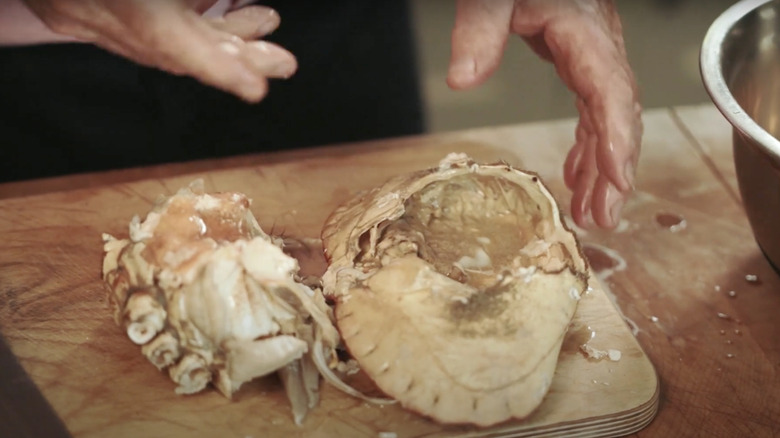White crab meat is a popular and versatile type of crab meat used in many delicious seafood dishes, But what exactly is white crab meat and where does it come from? This comprehensive guide will explain everything you need to know about this tasty crab product
Overview of White Crab Meat
-
White crab meat comes from the muscles of the crab’s body, legs, and claws It does not include the dark meat from the claws and shell.
-
The color ranges from white to ivory or light pink Dark brown crab meat comes from different parts of the crab.
-
It has a sweet, delicate, mildly briny flavor compared to the bolder taste of brown crab meat.
-
The texture is flaky when cooked but can be stringy when raw. It falls apart easily compared to lump crab meat.
-
White crab meat is sold fresh or canned for longer shelf life. Popular brands like Bumble Bee offer high-quality options.
-
It’s more expensive than imitation crab meat made from fish paste, but cheaper than premium lump crab meat.
-
White crab meat works well in crab cakes, seafood dishes, salads, sandwiches, pasta recipes, and more.
Where Does White Crab Meat Come From?
White crab meat comes from various sections of crabs:
-
Body: Delicate body meat and top filler meat are found here. This makes up a large portion of packaged white crab.
-
Legs: The leg muscle meat tends to be lighter in color than claw meat.
-
Claws: Smaller pieces of tender claw meat contribute to the mix.
-
Shoulders: The body meat around the top of shoulders is also white.
The smaller flakes from the body and legs produce the classic shredded texture of white crab meat. Larger sections of claw meat add more substantial chunks.
Popular crab species harvested for white crab meat include:
- Blue crabs from the Atlantic (backfin)
- Dungeness crabs from the Pacific
- Snow crabs from Alaska (economical)
- King crabs from Alaska (large quantity)
Flavor, Texture, Appearance
White crab meat has these classic characteristics:
-
Flavor: Sweet, delicate, mildly briny
-
Texture: Flaky when cooked; can be stringy when raw
-
Color: White, ivory, light pink; no dark meat
-
Fat Content: 1-2 grams per serving, low in fat
The tender flakes hold up during cooking without falling apart into mush. The mild sweetness complements other ingredients.
Nutrition Facts
-
Protein: 17g protein per 3.5 ounce serving
-
Vitamin B12: Over 100% DV
-
Selenium: Over 50% DV
-
Omega-3s: 250mg per serving
-
Minerals: High in copper, zinc, phosphorus
White crab meat provides quality complete protein and important vitamins and minerals. It’s low in mercury compared to some seafood choices.
How to Buy White Crab Meat
When purchasing packaged white crab meat, look for:
-
Fresh white color with no dark bits
-
Mild seafood aroma, not fishy/ammonia-like
-
Firm, not mushy texture
-
Labels indicating freshness
-
Use by 4 days after opening for best quality
Opt for reputable canned brands like Bumble Bee for convenient, long-lasting white crab meat.
How Much Does White Crab Meat Cost?
Expect to pay:
-
$7-$10 per pound for snow crab claw
-
$18-$26 per pound for jumbo lump
-
Around $4 per 6oz can for canned
White crab costs less than premium lump crab but more than imitation crab meat. Snow crab is very affordable. Watch for sales on your favorite variety!
How to Cook with White Crab Meat
White crab meat retains its flake when cooked gently. Avoid overmixing to prevent stringiness.
-
Fold delicately into dips, salads, pastas
-
Add at end to hot dishes
-
Bake into casseroles
-
Saute lightly for crab cakes
-
Heat through for crab rolls and melts
Dishes to Make with White Crab Meat
-
Classic Maryland crab cakes
-
Hot crab dip with crackers
-
Chilled crab salad wraps
-
Crab macaroni and cheese
-
Quiche or frittata with crab
-
Crab risotto or seafood paella
White crab meat enhances endless seafood recipes when handled with care.
Storing and Handling White Crab Meat
Follow proper storage and handling:
-
Refrigerate unopened up to 4 months; use opened within 4 days
-
Freeze for up to 3 months if not using right away
-
Thaw frozen crab meat overnight in the fridge
-
Avoid refreezing previously thawed meat
Proper chilling prevents bacterial growth and spoilage. Careful handling maintains the delicate texture.
Is Imitation Crab Meat Real?
Imitation crab meat contains minimal real crab, if any. It’s made from fish paste and flavorings to mimic crab for a budget-friendly alternative.
While lower in cost, it lacks the true flavor, texture, and nutrition of real white crab meat. Check the label to know what you’re getting.
Signs of Spoiled Crab Meat
Always fully inspect crab meat before use. Signs of spoilage include:
-
Sulfur or ammonia smell
-
Slimy texture or mushiness
-
Discoloration
-
Mold growth
-
Bubbling or foaming
When in doubt, throw it out! Follow recommended storage times.
Is Crab Meat Healthy?
Yes, crab meat offers many benefits when consumed in moderation as part of a healthy diet:
-
Excellent source of lean, complete protein
-
Rich in B12, selenium, copper, zinc
-
Provides omega-3s from cold water crab
-
Lower in mercury than some seafood
Enjoy delicious white crab meat as part of your balanced nutrition plan.
Key Takeaways
-
White crab meat comes from the body, legs, and claws of crabs. It has a sweet mild taste and tender flaky texture.
-
Look for freshness when buying and use within a few days. Handle gently when cooking to preserve texture.
-
White crab meat works well in everything from crab cakes to pasta dishes when properly handled.
-
Proper storage and handling prevents spoilage and retains the delicious flavor.
With this guide, you now have all the key facts on white crab meat. Enjoy this tasty and versatile ingredient in your favorite seafood recipes.

How to cook brown crab meat

When it comes to the texture of brown crab meat, its often a mixture thats gooey and paste-like, similar to a pâté or potted meat. Remember, brown meat is made of mostly organs and glands so youll get a smoother, mushier feel. As far as taste, you should expect an intense savoriness, with some sweetness and brininess thats best paired with other ingredients. By itself, the flavor may not be to everyones taste. For this reason, overall, brown crab meat is typically incorporated into dishes (in sauces, for instance) rather than being served on its own. To wit: You can combine brown crab meat with butter and lemon juice for a sauce for your fish and other seafood.
Likewise, layer some brown crab meat on a toasted bun with some olive oil, diced tomatoes, and cheese for a seafood take on a bruschetta. Of course, the main way many people enjoy brown crab meat is mixed up with white crab meat. It gives the latter a bit more depth and complexity. To mix up the two crab meats, all you need to do is make sure all of your brown crab meat is a fine mush. Layer in the white meat, but remember to be gentle with the delicate crab. Dont break up all of your white meat as you will want it to be a bit chunky. From there, you can add the mixture to a salad or pasta.
Stock Up! Crabmeat @Walmart
FAQ
Is white crab meat good?
White meat is found in the claws, legs and main body section of the crab. It is low in fat and high in protein. White crab meat is sweet and more delicate in flavour than brown meat and it has a moist, meaty, flaky texture. It is used in pasta dishes such as crab linguine and crab risotto.
What does white meat on crab mean?
This white meat comes from the muscle that propels the crab’s swimmer fins, and since each crab only has two of these swimmer fin muscles, jumbo lump crab meat is much harder to come by. It is universally loved for its mild, delicate flavor and sweet taste.
What is white crab meat made of?
White crab meat comes from the claws and legs. Predominantly white, it may exhibit a natural red or brown tinge.
What is the difference between lump crab meat and crab meat?
Lump Crab Meat: Consists of broken pieces of jumbo flakes and special crab meat from the body of the crab. Best for crab cakes, dips, salads, and casseroles. Special Crab Meat: This value crabmeat consists of smaller pieces of both lump and flake meat from the body of the crab.
What is white crab meat used for?
The meat on the left is white crab meat and the meat on the right is lump crab meat. White crab meat is best used as crab filling. White crab meat is less visually appealing as lump crab meat, but perfect as crab filling. Use it if you need a solid amount of crab for crab dip, crab rangoon, crab burgers, or crab meatloaf.
What is the difference between white and lump crab meat?
Take a look of the image below to see the difference between white and lump crab meat for yourself. The meat on the left is white crab meat and the meat on the right is lump crab meat. White crab meat is best used as crab filling. White crab meat is less visually appealing as lump crab meat, but perfect as crab filling.
Can you use white crab meat as crab filling?
White crab meat is best used as crab filling. White crab meat is less visually appealing as lump crab meat, but perfect as crab filling. Use it if you need a solid amount of crab for crab dip, crab rangoon, crab burgers, or crab meatloaf. It’s better for dishes where crab is mixed in and not for dishes that need larger chunks of crab.
What are the different types of crab meat?
Some grades work well as an elegant main ingredient, while others are perfect for blending into complex dishes. There are four main grades or types of crab meat. While jumbo lump, backfin and white crab meat all share similar coloring and flavor, the darker-colored claw meat has a bolder, more pronounced crab flavor than the other grades.
What is crab meat?
Crab meat, also known as crab marrow, is the edible meat found in a crab, or more specifically in its legs and claws. It is widely used in global cuisines for its soft, delicate and sweet flavor. Crab meat is low in fat, and provides about 340 kilojoules (82 kcal) of food energy per 85-gram (3 oz) serving.
